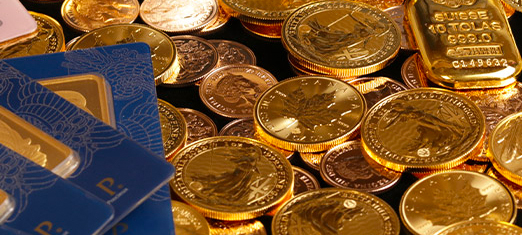.jpg)
Most precious metals investors hold a portfolio of gold and silver bullion and coins. However, it isn't always clear how much of each to hold.
Fortunately, the gold-silver ratio can help in decision-making. This article explores everything you need to know regarding the topic, including what the gold-silver ratio is, the factors that affect it, and how it can help investors make better portfolio allocation decisions.
What Is The Gold Silver Ratio?
The latest gold to silver ratio can be found here.
The gold-silver ratio is a metric that captures the relative value of an ounce of silver to an equal weight in gold. You can also view it as the amount of silver required to buy one ounce of gold. You can calculate the gold-silver ratio by dividing the current price of gold by the current price of silver.
Factors That Affect The Gold-Silver Ratio
Various factors affect the gold-silver ratio and because these are complex, it never remains constant for long.
Factors that affect the gold-silver ratio include:
- The economic uncertainty and instability in markets: Poor economic conditions may cause investors to flock towards gold as a safe-haven asset, increasing the gold-silver ratio.
- Changes in demand for silver or gold in industrial processes: Higher demand for silver in electronics or aerospace may push prices up, lowering the gold-silver ratio.
- The growth in the supply of one of the metals on a price-adjusted basis, compared to another: For instance, if the silver supply rises, the price of the precious metal may fall, leading to an increase in the gold-silver ratio.
- Inflation: Higher inflation expectations could push up the value of gold more than silver because it is more of a monetary metal, again increasing the gold-silver ratio.
The History Of The Gold-Silver Ratio
The history of the gold-silver ratio is extensive and goes back several thousand years to the first use of precious metals as money.
In early modern Europe, around 1600 AD, the ratio reached 1:15, as large amounts of silver were imported from the Americas by Spain and Portugal. Then in the U.S. in 1792, the ratio was fixed at 1:15 by the Coinage Act, which established the bimetallic standard and defined the dollar as 371.25 grains of silver or 24.75 grains of gold.
Later in the 19th century, the ratio rose considerably to 1:30, as many countries adopted the gold standard and demonetised silver. In the late 20th century, the ratio fell to 1:15 in 1980, as silver prices soared due to market speculation and manipulation by the Hunt brothers. So far this century, the ratio has been between 1:30 and 1:100 as silver entered the underpricing territory.
Why The Gold-Silver Ratio Matters To Investors
The gold-silver ratio matters to investors because it tells them whether one metal is overvalued compared to another. Historically, it has fluctuated between 15:1 and 100:1, and today, it is close to the upper end of that range, suggesting silver may appreciate in the future.
Advantages And Disadvantages Of Investing In Gold And Silver, Based On The Gold-Silver Ratio

The advantages of investing in gold and silver based on the gold-silver ratio are that:
- You can see whether either metal is historically expensive or cheap
- You can make better portfolio allocation decisions
However, the disadvantages are that:
- The gold-silver ratio tells you nothing about tertiary factors (such as mining or interest rates) affecting the relative price.
- Investors may need to pay taxes when transitioning their portfolios between the metals
How Does The Gold-Silver Ratio Compare To Other Metrics For Understanding Precious Metals Market Trends?
The gold-silver ratio provides data regarding conditions within the precious metals market. However, it doesn’t provide contextual information.
The metric is a complex construction influenced by numerous factors discussed above. For instance, the ratio tends to increase during periods of uncertainty or crisis, when investors favour gold as a safe haven asset over silver. Conversely, the ratio tends to decrease during periods of growth or optimism, when silver benefits from its industrial applications and higher volatility.
With that said, other metrics don’t fare much better. Investing based on the relative price of other assets is not necessarily a winning strategy since precious silver prices and gold prices can remain low for a long time.
Some investors take account of similar metrics, such as the platinum-palladium ratio. These assist in understanding the precious metals markets by telling investors whether one metal is cheap compared to another. Again, though, these metrics don’t take into account tertiary factors.
Strategies For Investing In Precious Metals, Based On The Gold-Silver Ratio
Some investors use the gold-silver ratio to engage in “ratio trading.” This approach involves comparing the relative performance of gold and silver prices to identify potential trading opportunities. For instance, if the price of silver is low in terms of gold, some investors may take that as a signal to buy it.
Investors also sometimes use hedging strategies. Here, they use the ratio to switch between gold and silver depending on their expectations of future price movements. By doing so, they can reduce their exposure to market volatility and diversify their portfolio.
Risks And Challenges Of Investing In Gold And Silver Based On The Gold-Silver Ratio
Of course, with any trading strategy, there are risks. One of the risks of investing in gold and silver based on the gold-silver ratio is market volatility. The ratio can change significantly over time and reveal what seemed like good investment decisions to be poor.
Another problem is storage. Keeping silver and gold safe is challenging and may present a significant overhead.
Conclusion
In summary, the gold-silver ratio is a helpful tool for pricing these precious metals. However, investors should use it with caution. It is not the only data they should consider when making portfolio allocation decisions.


.jpg)













